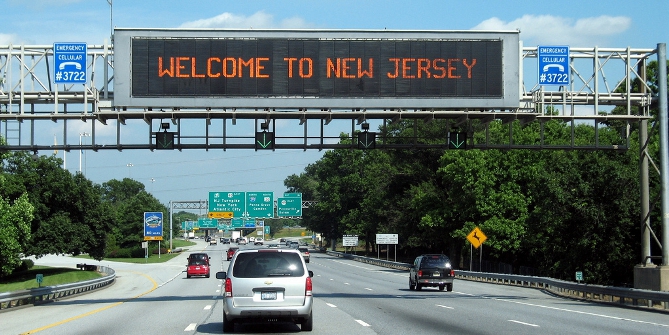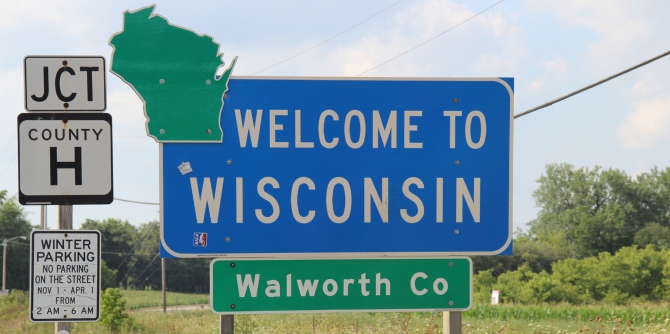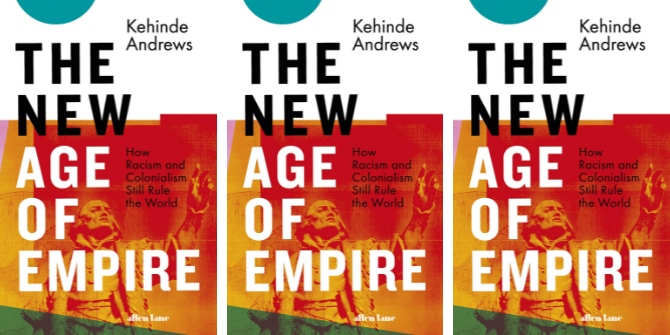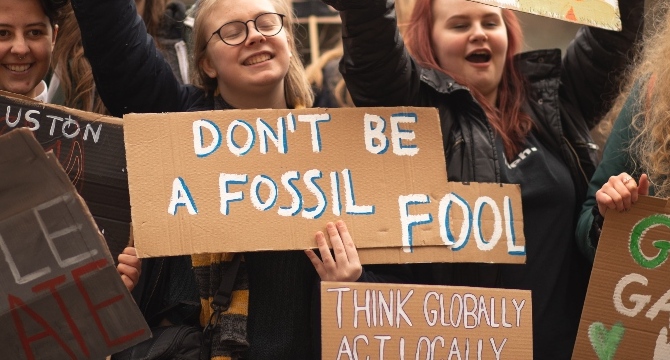

 In new research, Natalie Masuoka, Kumar Ramanathan, and Jane Junn cast doubt on notion that immigrants are less engaged with politics than native born Americans. Analyzing nation-wide survey data, they find that those immigrants who do have citizenship are just as likely and potentially more likely to vote than those born in the US. In addition, looking at political activities that do not require citizenship, they also determine that non-citizens participate at a similar rate to citizens.
In new research, Natalie Masuoka, Kumar Ramanathan, and Jane Junn cast doubt on notion that immigrants are less engaged with politics than native born Americans. Analyzing nation-wide survey data, they find that those immigrants who do have citizenship are just as likely and potentially more likely to vote than those born in the US. In addition, looking at political activities that do not require citizenship, they also determine that non-citizens participate at a similar rate to citizens.
Today, it is conventional wisdom that immigrants are less likely to vote compared to native born Americans. Our analysis shows, however, that this does not necessarily mean that immigrants aren’t engaged in American politics. Traditionally, political scientists have studied voting behavior by focusing on the role of individual characteristics such as a person’s educational level, their age or their gender and seek to determine the unique impact of that individual-level factor on voter turnout when you control for all other factors. These types of analyses indeed show that when you look at the entire population, immigrants on average participate at lower rates compared to native born Americans. Yet, this strategy misses the other important structural conditions that can advantage or disadvantage individuals from engaging in the US political system.
For immigrants, factors such as naturalization and English-language proficiency strongly condition their political participation as barriers to activity that non-immigrants do not face. So, immigrants who are citizens and registered represent a very different group compared to non-citizen immigrants. Since immigrant voters have to clear more hurdles to participate in politics relative to a native born American, it might not be a complete story to say that immigrants are a civically disengaged group and in fact could be taking part in politics to a greater extent than the conventional wisdom might lead you to believe.
In new research, we highlight the participation rates of Asian Americans, the racial group with the largest share of immigrants but also, because of immigration, the fastest growing racial group in the United States. We argue that scholars should group individuals who share the same institutional hurdles and analyze them as distinct subpopulations. In our study, we used data from the Current Population Survey and the 2016 Collaborative Multiracial Post-Election Survey (CMPS) and disaggregated the Asian American samples by their incorporation status. We draw comparisons between different pairings: citizens versus non-citizens and registered versus non-registered. Among those who are registered voters, we also divided the sample into those who are naturalized citizens and native-born Americans. By disaggregating the data in these ways, we theorize that shared structural impediments lead to similar challenges for political participation, and thus the method used to evaluate behavior should account for the importance of such barriers.
As Figure 1 shows, among voting age Asian Americans, 74 percent were born outside of the United States. Given such a large share of immigrants, formal eligibility to participate in politics serves as a crucial hurdle to participation: 31 percent of Asian American adults are ineligible to vote due to their non-citizen status. Recognition of these structural barriers helps better explain why rates of voting among Asian Americans look the way they do. For example, 34 percent of all adult Asian Americans voted in 2016 but the rate rises to 49 percent if one considers only eligible adult Asian Americans.
Figure 1 – Characteristics and political participation of Asian Americans
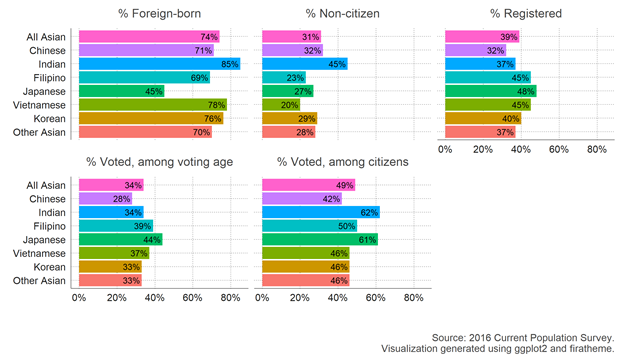
Once we disaggregate Asian Americans into the six largest national origin groups, we can see that formal inclusion into the political system varies significantly (Figure 1). Except for Japanese Americans (a majority of whom are native-born), the remaining national origin groups are made up mostly of immigrants. Not all these groups experience the same rate of formal inclusion in the US political system. For example, Asian Indians have the highest rate of exclusion from the political system, with 45 percent being non-citizens. In contrast, 20 percent of Vietnamese and 23 percent of Filipino adults are non-citizens.
Voter participation varies widely with the lowest rate of voter turnout among Chinese (42 percent) and the highest rate among Asian Indians (62 percent). Strikingly, Asian Indians demonstrate a unique picture of political incorporation wherein those who are eligible turn out at high rates, even though nearly half of the population is formally excluded due to their non-citizen status. Another important pattern can be found when we disaggregate voting rates by people’s place of birth. Even though past research suggests that length of time in the United States increases the rate of voting, this is not always the case once we take citizenship and registration into account. We find that among Filipinos, Asian Indians, Vietnamese and other Asians (those not of one of the six largest national origin groups), immigrants vote at higher rates than the native born. Our analysis confirms that children of immigrants are no more or less likely to vote than their immigrant parents, although those in the third generation (grandchildren of immigrants) or beyond are more likely to vote compared to immigrants.
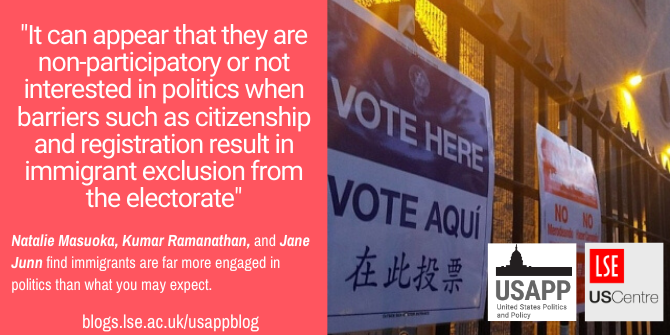
“#Vote Here #Vote Aquí #ImWithHer” by joy garnett is licensed under CC BY NC SA 2.0
Participation in voting tends to capture a set of politically integrated individuals. By accounting for non-electoral activity, we can analyze participation among all Asian Americans, including non-citizens. We looked at participation in nine non-electoral activities (for example contacting a government official about a problem, working with one’s community to solve a problem, or discussing politics with others). As seen in Figure 2, the mean number of non-electoral acts for all incorporation groupings in the sample is relatively low but this is consistent with participation rates for the entire population given that Americans are generally not highly participatory in politics.
Strikingly, the difference in non-electoral participatory acts across citizens and non-citizens fails to reach significance so while the mean for citizens is higher than that of non-citizens, we are not confident that difference is a real one. If we analyze only citizens, we also find narrow differences in between those who are naturalized immigrants and the native born. Where we seem to find the most substantial difference is that between registered and non-registered. In fact, the raw mean for non-citizens is higher compared to the non-registered. Since non-registered Asian Americans are choosing not to participate in voting rather than being excluded through structural barriers, they are generally not involved in politics.
Figure 2 – Average number of non-election related political participation acts
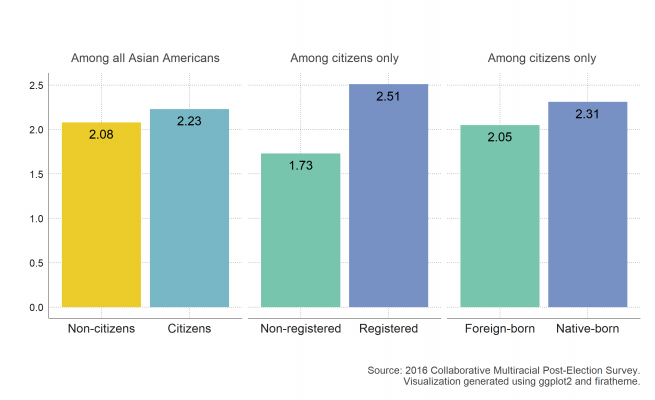
Our analysis shows that the low visibility of Asian Americans in the American electorate is partially because this is a group that is overwhelmingly foreign born. It can appear that they are non-participatory or not interested in politics when barriers such as citizenship and registration result in immigrant exclusion from the electorate. Our analysis of 2016 data shows however, that once you take citizenship and registration into account, there were some Asian American immigrant groups that voted at higher rates than their US born second generation children. Moreover, when looking at non-electoral activity that does not require citizenship status, we found that non-citizens participate at equal rates as citizens. Overall, our findings suggest that the relationship between immigrant generation and political participation is not always linear, and immigrants can be just as interested and active in politics as the native born.
- This article is based on the paper, ’New Asian American Voters: Political Incorporation and Participation in 2016’ in Political Research Quarterly.
Please read our comments policy before commenting.
Note: This article gives the views of the author, and not the position of USAPP – American Politics and Policy, nor of the London School of Economics.
Shortened URL for this post: http://bit.ly/37LazOq
About the authors
 Natalie Masuoka – UCLA
Natalie Masuoka – UCLA
Natalie Masuoka is Associate Professor of Political Science and Asian American Studies at UCLA. Her research interests include racial and ethnic politics, immigration, and voting in American elections. Her most recent book, Multiracial Identity and Racial Politics in the U.S. (2017 Oxford University Press) examines the implications of the racial identification question on the US Census and highlights the rise of mixed race identities.
 Kumar Ramanathan – Northwestern University
Kumar Ramanathan – Northwestern University
Kumar Ramanathan PhD candidate in political science at Northwestern University. His research agenda explores the relationship between the policy process and social inequalities in the United States, with a focus on civil rights, social policy, and immigration policy.
 Jane Junn – USC
Jane Junn – USC
Jane Junn is Professor of Political Science at the University of Southern California.







